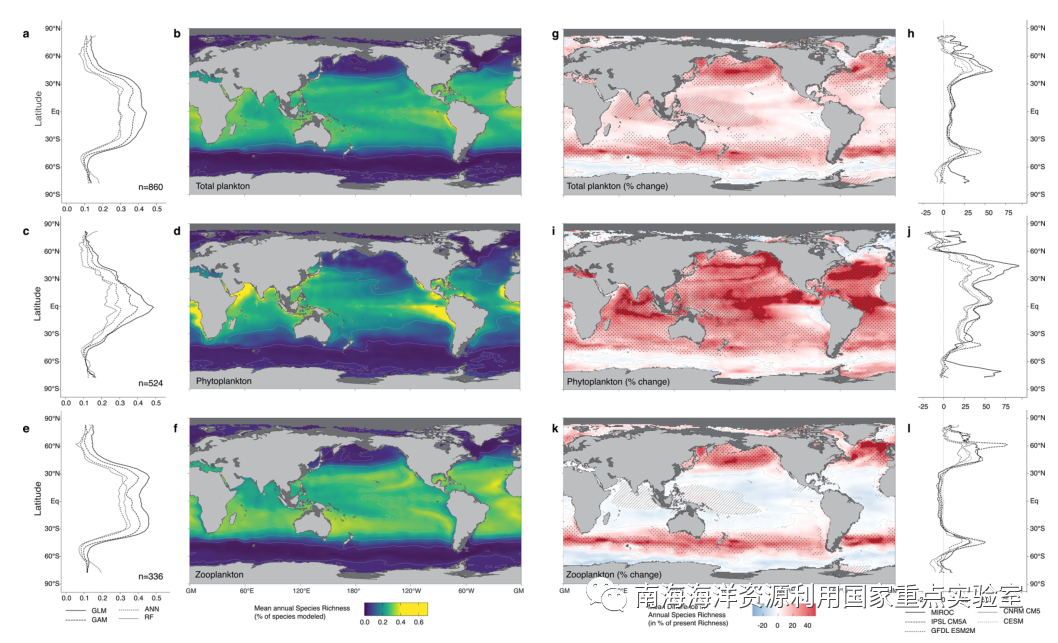海洋浮游植物和浮游动物构成了海洋食物网的基础,但是人们对气候变化对生物多样性的影响知之甚少。在这里,来自生物地球化学研究所的研究人员Fabio Benedetti等在2021年在国际顶尖期刊《Nature Communications》上发表了一篇名为“Major restructuring of marine plankton assemblages under global warming”的研究论文,文章的中文译名是《全球变暖下海洋浮游生物群落的重大重组》。作者使用336种浮游植物和524种浮游动物的物种分布模型来确定目前和未来它们的栖息地适宜性模式。
Marine phytoplankton and zooplankton form the basis of the ocean’s food-web, yet the impacts of climate change on their biodiversity are poorly understood. Fabio Benedetti and other research fellows from Institute of Biogeochemistry and Pollutant Dynamics published a paper entitled “Major restructuring of marine plankton assemblages under global warming” whose Chinese name was “全球变暖下海洋浮游生物群落的重大重组” in the international top journal Nature Communications in 2021. The researchers use an ensemble of species distribution models for a total of 336 phytoplankton and 524 zooplankton species to determine their present and future habitat suitability patterns.

海洋浮游生物的物种多样性决定了海洋生态系统服务。在阳光照射的海洋层中,光自养浮游植物占地球年净初级生产力的50%左右。浮游植物主要由异养浮游动物放牧,这些浮游植物反过来维持全球鱼类的生产。这两种营养水平共同驱动生物碳泵,这也是决定海洋大气二氧化碳平衡的关键因素。同时,浮游植物的多样性和大小结构也会影响重要经济鱼类的繁殖。浮游生物的多样性很大程度受气候的控制,温度是主要驱动力。温度可以增加物种的代谢率和选择更多物种促进物种多样性。然而,海洋变暖会促使物种向极地转移其分布范围,以追踪最佳的栖息地。但全球变暖预计会通过物种推到热极限之外后,通过重组群落组成,就会引起物种灭绝。
The species diversity of marine plankton governs some of the most important marine ecosystem services. In the sun-lit layers of the oceans, photoautotrophic phytoplankton are responsible for about 50% of Earth’s annual net primary production. Phytoplankton are mainly grazed by the heterotrophic zooplankton, which in turn sustain global fisheries production. Together, these two trophic levels drive the biological carbon pump, a key determinant of the ocean-atmosphere balance of CO2. The diversity of phyto- and zooplankton has been shown to be a key modulator of this pump. Similarly, the diversity and size structure of the zooplankton mediate the recruitment of economically important fishes. The majority of studies indicate that the diversity of phyto- and zooplankton is largely controlled by climate, with temperature being the main driver. Warm temperatures promote species diversity by enhancing speciation, metabolic rates and selecting for a higher number of species. However, ocean warming forces species to shift their distribution ranges poleward to track their optimal thermal habitats. Furthermore, future global warming is expected to trigger species extirpations by pushing species beyond their thermal limits and by restructuring community composition.

作者通过物种分布模型的集成方法,对跨越13门、71目和324属的860种浮游植物的分布的月和年平均多样性模式进行建模,记录露天海洋记录和环境预测因子,假定生态保守性,实施耦合模型相互比较,将栖息地适宜性模型输出。
The researchers model the monthly and mean annual diversity patterns stemming from the distribution of 860 plankton species (336 phytoplankton, 524 zooplankton) spanning 13 phyla, 71 orders, and 324 genera through an ensemble approach based on species distribution models (SDMs). And they match these binned open ocean records with observation-based climatologies of environmental predictors (temperature, dissolved oxygen concentration, solar irradiance, macronutrients concentration, chlorophyll a concentration) that reflect the climatic and biogeochemical conditions of the surface open ocean. Assuming niche conservatism, they project each of the 16 resulting habitat suitability models into the future using outputs from five ESMs belonging to the Coupled Model Intercomparison Project.

最后作者发现,在本世纪末,在高排放情境下我们发现受海洋变暖驱动的浮游生物物种丰富度总体增加,物种分布以35公里/十年的中位速度向极地移动。除北冰洋外,大多数地区的浮游植物物种丰富预计将增加16%以上。相比之下,预计热带浮游动物的丰度将略有下降,但是温带至亚极地纬度地区的浮游动物丰度大幅度增加。在这些纬度地区,近40%的浮游植物和浮游动物组合被向极地迁移的物种取代。这意味着气候变化是会威胁到浮游生物对浮游生物介导的生态系统服务的贡献。
In the end, the researchers ensemble of models project phytoplankton SR to increase by more than 16% in most basins except the Arctic Ocean and zooplankton SR to strongly increase in temperate to subpolar latitudes (+24%) but to slightly decline in the tropics (−4%). In the temperate and subpolar latitudes, turnover rates as high as 40% are predicted for the mean annual phyto- and zooplankton assemblages compositions, which implies that future climate change threatens the plankton-mediated ecosystem services provided by the ocean in these regions.


参考文献:https://www.nature.com/articles/s41467-021-25385-x
简述翻译者:海南大学研究生王晨
 公众号
公众号